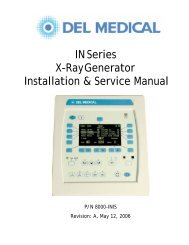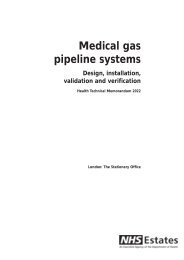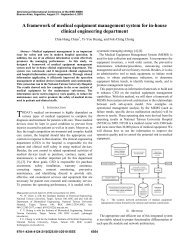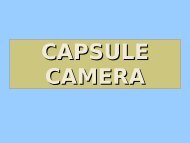Electrosurgery Self-Study Guide
Electrosurgery Self-Study Guide
Electrosurgery Self-Study Guide
Create successful ePaper yourself
Turn your PDF publications into a flip-book with our unique Google optimized e-Paper software.
<strong>Electrosurgery</strong> <strong>Self</strong>-<strong>Study</strong> <strong>Guide</strong><br />
18<br />
• Position cords so that people cannot trip over them.<br />
Do not roll equipment over electrical cords.<br />
• If the patient is moved or repositioned, check the<br />
patient return electrode to be sure that it is still in<br />
good contact with the patient. Patient return<br />
electrodes should not be repositioned. If the patient<br />
return electrode is removed for any reason, a new<br />
pad should be used.<br />
• When an active electrode is not in use, remove it<br />
from the surgical field and from contact with the<br />
patient. An insulated holster should always be used.<br />
• Do not coil active electrode cables, or grounding<br />
pad cables. This will increase leakage current and<br />
may present a potential danger to the patient.<br />
• If possible, avoid “buzzing” hemostats in a way that<br />
creates metal to metal arcing. If “buzzing” a hemostat<br />
is necessary, touch the hemostat with the active<br />
electrode and then activate the generator. This will<br />
help eliminate unwanted shocks to surgical team<br />
members.<br />
• Use endoscopes with insulated eye pieces.<br />
• Keep active electrodes clean. Eschar build-up will<br />
increase resistance, reduce performance, and require<br />
higher power settings.<br />
• Do not submerse active accessories in liquid.<br />
• Note the type of active electrode used on the<br />
perioperative record.<br />
• If an ESU alarm occurs, check the system to assure<br />
proper function. Document any alarm intervention.<br />
• Do not use the generator top as a storage space for<br />
fluids. Spills could cause malfunctions (Hutchisson,<br />
1998).<br />
Postoperative<br />
• Turn off the ESU.<br />
• Turn all dials to zero.<br />
• Disconnect all cords by grasping the plug, not the<br />
cord.<br />
• Inspect patient return electrode site to be sure it is<br />
clear of injury (AORN, 1999).<br />
• Inspect patient return electrode after removal. If an<br />
undetected problem has occurred, such as a burn,<br />
evidence of that burn may appear on the pad.<br />
• Discard all disposable items according to hospital<br />
policy.<br />
• Remove and discard the plastic bag covering the foot<br />
pedal.<br />
• Clean the ESU, foot pedal, and power cord.<br />
• Coil power cords for storage.<br />
• Clean all reusable accessories.<br />
Routine Care and Maintenance of<br />
ESU Equipment<br />
• Routinely replace all reusable cables and active<br />
electrodes at appropriate intervals, depending upon<br />
usage.<br />
• Have a qualified Biomedical Engineer inspect the unit<br />
at least every six months.<br />
• If an ESU is dropped, a Biomedical Engineer should<br />
inspect it before it is used again.<br />
• Replace adapters that do not provide tight<br />
connections.<br />
• Inspect “permanent” cords and cables for cracks in<br />
the insulation.<br />
Proper use and maintenance of electrosurgical equipment<br />
can prolong its life and reduce costly repairs.<br />
Summary<br />
Surgeons and perioperative nurses have the opportunity<br />
to combine their unique technical skills and knowledge<br />
with the latest technology to provide high quality patient<br />
care. Positive patient outcomes can be successfully<br />
achieved through good medical and nursing practice<br />
combined with careful documentation. The importance of<br />
skill and knowledge is especially critical during the use of<br />
electrosurgery. An educated surgeon or nurse is the<br />
patient’s best advocate.










